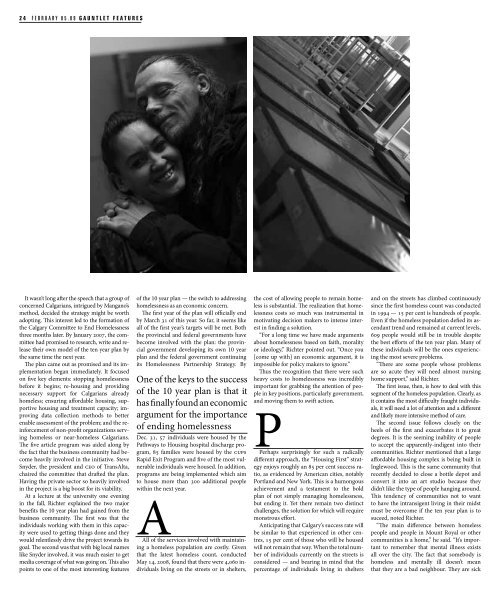PDF Edition - The Gauntlet
PDF Edition - The Gauntlet
PDF Edition - The Gauntlet
Create successful ePaper yourself
Turn your PDF publications into a flip-book with our unique Google optimized e-Paper software.
24 FEBRUARY 05.09 GAUNTLET FEATURES<br />
It wasn’t long after the speech that a group of<br />
concerned Calgarians, intrigued by Mangano’s<br />
method, decided the strategy might be worth<br />
adopting. This interest led to the formation of<br />
the Calgary Committee to End Homelessness<br />
three months later. By January 2007, the committee<br />
had promised to research, write and release<br />
their own model of the ten year plan by<br />
the same time the next year.<br />
<strong>The</strong> plan came out as promised and its implementation<br />
began immediately. It focused<br />
on five key elements: stopping homelessness<br />
before it begins; re-housing and providing<br />
necessary support for Calgarians already<br />
homeless; ensuring affordable housing, supportive<br />
housing and treatment capacity; improving<br />
data collection methods to better<br />
enable assessment of the problem; and the reinforcement<br />
of non-profit organizations serving<br />
homeless or near-homeless Calgarians.<br />
<strong>The</strong> five article program was aided along by<br />
the fact that the business community had become<br />
heavily involved in the initiative. Steve<br />
Snyder, the president and CEO of TransAlta,<br />
chaired the committee that drafted the plan.<br />
Having the private sector so heavily involved<br />
in the project is a big boost for its viability.<br />
At a lecture at the university one evening<br />
in the fall, Richter explained the two major<br />
benefits the 10 year plan had gained from the<br />
business community. <strong>The</strong> first was that the<br />
individuals working with them in this capacity<br />
were used to getting things done and they<br />
would relentlessly drive the project towards its<br />
goal. <strong>The</strong> second was that with big local names<br />
like Snyder involved, it was much easier to get<br />
media coverage of what was going on. This also<br />
points to one of the most interesting features<br />
of the 10 year plan — the switch to addressing<br />
homelessness as an economic concern.<br />
<strong>The</strong> first year of the plan will officially end<br />
by March 31 of this year. So far, it seems like<br />
all of the first year’s targets will be met. Both<br />
the provincial and federal governments have<br />
become involved with the plan: the provincial<br />
government developing its own 10 year<br />
plan and the federal government continuing<br />
its Homelessness Partnership Strategy. By<br />
One of the keys to the success<br />
of the 10 year plan is that it<br />
has finally found an economic<br />
argument for the importance<br />
of ending homelessness<br />
Dec. 31, 57 individuals were housed by the<br />
Pathways to Housing hospital discharge program,<br />
85 families were housed by the CUPS<br />
Rapid Exit Program and five of the most vulnerable<br />
individuals were housed. In addition,<br />
programs are being implemented which aim<br />
to house more than 300 additional people<br />
within the next year.<br />
AAll of the services involved with maintaining<br />
a homeless population are costly. Given<br />
that the latest homeless count, conducted<br />
May 14, 2008, found that there were 4,060 individuals<br />
living on the streets or in shelters,<br />
the cost of allowing people to remain homeless<br />
is substantial. <strong>The</strong> realization that homelessness<br />
costs so much was instrumental in<br />
motivating decision makers to intense interest<br />
in finding a solution.<br />
“For a long time we have made arguments<br />
about homelessness based on faith, morality<br />
or ideology,” Richter pointed out. “Once you<br />
[come up with] an economic argument, it is<br />
impossible for policy makers to ignore.”<br />
Thus the recognition that there were such<br />
heavy costs to homelessness was incredibly<br />
important for grabbing the attention of people<br />
in key positions, particularly government,<br />
and moving them to swift action.<br />
PPerhaps surprisingly for such a radically<br />
different approach, the “Housing First” strategy<br />
enjoys roughly an 85 per cent success ratio,<br />
as evidenced by American cities, notably<br />
Portland and New York. This is a humongous<br />
achievement and a testament to the bold<br />
plan of not simply managing homelessness,<br />
but ending it. Yet there remain two distinct<br />
challenges, the solution for which will require<br />
monstrous effort.<br />
Anticipating that Calgary’s success rate will<br />
be similar to that experienced in other centres,<br />
15 per cent of those who will be housed<br />
will not remain that way. When the total number<br />
of individuals currently on the streets is<br />
considered — and bearing in mind that the<br />
percentage of individuals living in shelters<br />
and on the streets has climbed continuously<br />
since the first homeless count was conducted<br />
in 1994 — 15 per cent is hundreds of people.<br />
Even if the homeless population defied its ascendant<br />
trend and remained at current levels,<br />
609 people would still be in trouble despite<br />
the best efforts of the ten year plan. Many of<br />
these individuals will be the ones experiencing<br />
the most severe problems.<br />
“<strong>The</strong>re are some people whose problems<br />
are so acute they will need almost nursing<br />
home support,” said Richter.<br />
<strong>The</strong> first issue, then, is how to deal with this<br />
segment of the homeless population. Clearly, as<br />
it contains the most difficulty fraught individuals,<br />
it will need a lot of attention and a different<br />
and likely more intensive method of care.<br />
<strong>The</strong> second issue follows closely on the<br />
heels of the first and exacerbates it to great<br />
degrees. It is the seeming inability of people<br />
to accept the apparently-indigent into their<br />
communities. Richter mentioned that a large<br />
affordable housing complex is being built in<br />
Inglewood. This is the same community that<br />
recently decided to close a bottle depot and<br />
convert it into an art studio because they<br />
didn’t like the type of people hanging around.<br />
This tendency of communities not to want<br />
to have the intransigent living in their midst<br />
must be overcome if the ten year plan is to<br />
suceed, noted Richter.<br />
“<strong>The</strong> main difference between homeless<br />
people and people in Mount Royal or other<br />
communities is a home,” he said. “It’s important<br />
to remember that mental illness exists<br />
all over the city. <strong>The</strong> fact that somebody is<br />
homeless and mentally ill doesn’t mean<br />
that they are a bad neighbour. <strong>The</strong>y are sick

















